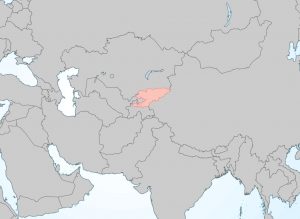81 Central Asia: Cultural Geog I – Bride Kidnapping in Kyrgyzstan
In the United States, marriages are made out of love and commitment between willing partners. Weddings are joyous affairs, celebrating the future of partners excited to pledge their lives together. Almost always. There are a few arranged marriages, but almost entirely among immigrant communities, especially for more recent migrants. Historically and occasionally in contemporary America, a few weddings are compelled between a couple where an unplanned pregnancy has accelerated the path toward marriage. These “shotgun weddings” were demanded, perhaps at gunpoint, by angry fathers of pregnant young daughters.
Across the world there are many cultural differences in regard to weddings and marriages. Certainly, arranged marriages have been a historical norm in India and in many other countries. Even so, the culture of bride kidnappings in Kyrgyzstan seems to be a step over the line of decency and certainly greatly diminishes the autonomy of young women there.
Let’s be clear. Not all of the marriages in Kyrgyzstan are the result of bride kidnappings; however, from the viewpoint of human rights, no marriages should be the result of kidnapping a woman to force her to marry a man, even if the man is known to her. In Kyrgyzstan, research indicates that about a third of rural marriages begin with kidnapping the bride. Urban areas, where 40% of the country’s population reside, tend to be more progressive and have women who have greater economic clout; thus, cities have fewer bride kidnappings.

So, how do these abductions occur? A young Kyrgyz man becomes attracted to a young Kyrgyz woman. This is not so different than circumstances around the world. The man might actively court the woman, including going on dates with her. Or, the man may express interest, but meet diffidence, disinterest, or rejection in return. Sometimes the man may be attracted to the woman, but doesn’t approach her, perhaps due to shyness or embarrassment.
Therefore, the woman might be courted, might be acquainted, or might be unaware, all depending on the man’s approach. Of course, these levels of interaction between young men and young men have been present in all sort of societies and perhaps from the beginning of time. Sometimes, in America too, there will be miscommunications that lead to awkward moments or embarrassment. At times, obsessions may prompt violence or sexual assault. The twist in Kyrgyzstan is that the young man may kidnap the young women to propel her into marriage.
Upon deciding that he wants to marry the woman, the man organizes a group of his male friends to plan the kidnapping. Typically, the kidnapping takes place in a public place. The apparent intent is not a dangerous home break-in nor an assault in a dark alley, but a celebratory public heist, taking the potential bride as prize. Without the brutality of striking blows, the group of kidnappers simply overwhelms the bride with numbers, in order to push, propel, or carry her into a nearby vehicle. Bystanders or the woman’s female friends simply stand by, recognizing the cultural custom.

Usually, the group drives to the man’s family residence, where his female relatives (mother, sister, aunt) seek to persuade to bride-to-be to accept the “proposal” gracefully and without incident or complaint. This acquiescence rather nicely smooths the way for the wedding and marriage to begin; however, not all women accept an apparent inevitability of this result. In two recent cases, young women who resisted were murdered.
A twist on this practice of abduction is the bride who wishes to be taken. Sometimes the couple already is in love, but finds the drama of a kidnapping to be appealing and exciting. In other cases, the couple again is in love, but now the woman’s father disapproves of the suitor. The bride kidnapping forces the father’s hand in relenting to the pairing.
One consequence of bride kidnappings in Kyrgyzstan is an increase in migration. Rural Kyrgyz women may move to urban areas in order to reduce the risk of being kidnapped into this coercive marital arrangement. In general, Kyrgyz women may leave the country, seeking opportunity in other Central Asian countries or even in Russia. In Geography, this would be an example of push migration. In examining the origin and destinations of migration, geographers explain that this type of migration features an origin that is dangerous or even life-threatening. Often push migration is caused by a natural disaster, such as a hurricane or earthquake that destroys homes; however, manmade oppression, discrimination, and assault also lead to out-migration. Indeed, Kyrgyz women of marriage age may feel a compulsion to flee their homes before a kidnapping comes to fruition.

This photo shows two Kyrgyz women participating in the Orange the World movement that calls for an end to violence against women.
Did you know?
In Season 2, Episode 10, of CSI: Miami, actor Chris Pine’s character books a fake kidnapping for his wealthy heiress girlfriend, so that she can experience the exhilaration of an extreme event. Mayhem follows. There is no TV series CSI: Kyrgyzstan.
To learn about some great Kyrgyz cuisine, take a look at the food video series Silk Road Tastes on YouTube. Great food, sometimes unusual food (for Americans), sometimes great scenery.
Cited and additional bibliography:
Hofmann, Erin, and Guangqing Chi. “‘Bride Kidnapping’ Haunts Rural Kyrgyzstan, Causing Young Women to Flee Their Homeland.” The Conversation, http://theconversation.com/bride-kidnapping-haunts-rural-kyrgyzstan-causing-young-women-to-flee-their-homeland-158404.
Ninara. Bishkek, Kyrgyzstan. 19 July 2018. Flickr, https://www.flickr.com/photos/ninara/44662807151/. Attribution 2.0 Generic (CC BY 2.0)
UN Women. Orange the World 2018 – Kyrgyzstan. 23 Nov. 2018. Flickr, https://www.flickr.com/photos/unwomen/31363822417/. Attribution-NonCommercial-NoDerivs 2.0 Generic (CC BY-NC-ND 2.0).
Wiertz, Steve. Tajikistan. College of DuPage GIS class. May 2022.


